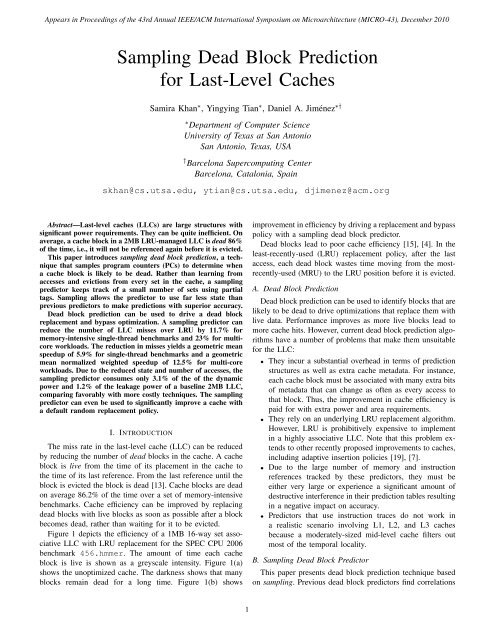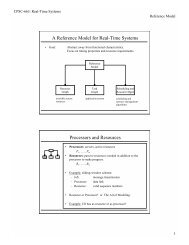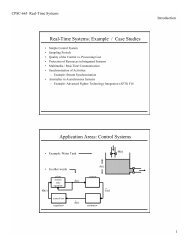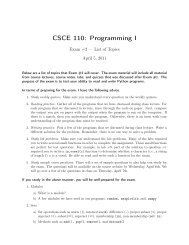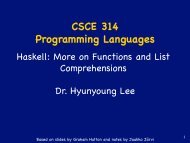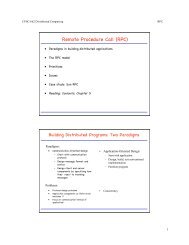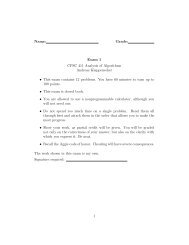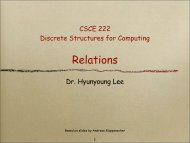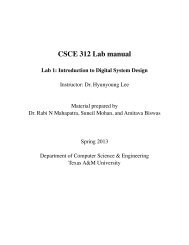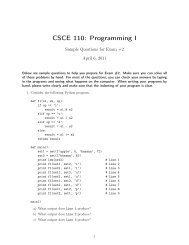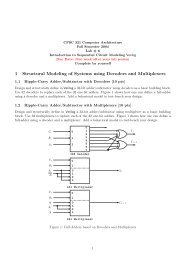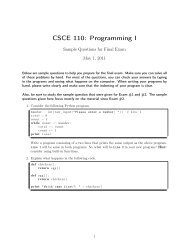Sampling Dead Block Prediction for Last-Level Caches - TAMU ...
Sampling Dead Block Prediction for Last-Level Caches - TAMU ...
Sampling Dead Block Prediction for Last-Level Caches - TAMU ...
You also want an ePaper? Increase the reach of your titles
YUMPU automatically turns print PDFs into web optimized ePapers that Google loves.
L2 CacheData accessL2 CachePredictorTableData accessEvery L2 miss, <strong>for</strong>prediction and training<strong>Prediction</strong>Every LLC eviction,<strong>for</strong> training(a)<strong>Last</strong>−<strong>Level</strong> CacheEvery L2 Selected L2 misses,miss, <strong>for</strong> <strong>for</strong> training only,predictiononly< 1.6% of LLC accessesSamplertag array32 setsSampleraccessesand evictionsPredictorTable<strong>Prediction</strong>(b)<strong>Last</strong>−<strong>Level</strong> Cache2048 sets, tags + dataFig. 2: Reftrace dead block predictor (a), and new dead block predictor with sampler tag array (b). The sampler anddead block predictor table are updated <strong>for</strong> 1.6% of the accesses to the LLC, while the reftrace predictor is updated onevery access.Reference trace predictorindex = blk.signatureSkewed sampling predictorindex1 = hash1(blk.signature)index2 = hash2(blk.signature)index3 = hash3(blk.signature)confidence1confidence3confidenceconfidence2dead if confidence >= threshold dead if confidence1+confidence2+confidence3 >= thresholdFig. 3: <strong>Block</strong> diagrams <strong>for</strong> dead block predictors+A. Reference Trace PredictorFor this study, we use a reftrace predictor indexed using15-bit signature. Thus, the prediction table contains 2 15 twobitcounters, or 8KB. We find diminishing returns in termsof accuracy from larger tables, so we limit our reftracepredictor to this size. Each cache block is associated withtwo extra fields: the 15-bit signature arising from the mostrecent sequence of accesses to that block, and another bit thatindicates whether the block has been predicted as dead. With a2MB cache with 64B blocks, this works out to 64KB of extrametadata in the cache. Thus, the total amount of state <strong>for</strong> thereftrace predictor is 72KB, or 3.5% of the data capacity of theLLC.B. Counting PredictorThe counting-based Live-time Predictor (LvP) predictor[11] is a 256 × 256 table of entries, each of whichincludes the following fields: a four-bit counter keeping trackof the number of accesses to a block and a one-bit confidencecounter. Thus, the predictor uses 40KB of storage. In addition,each cache block is augmented with the following metadata:an eight-bit hashed PC, a four-bit counter keeping track of thenumber of times the cache block is accessed, a four-bit numberof accesses to the block from the last time the block was inthe cache, and a one-bit confidence counter. This works outto approximately 68KB of extra metadata in the cache. Thus,the total amount of state <strong>for</strong> the counting predictor is 108KB,or 5.3% of the data capacity of the LLC.C. <strong>Sampling</strong> PredictorThe three prediction tables <strong>for</strong> the skewed dead blockpredictor are each 4,096 two-bit counters so they consume3KB of storage.We model a sampler with 32 sets. Each set has 12 entriesconsisting of 15-bit partial tags, 15-bit partial PCs, one predictionbit, one valid bit, and four bits to maintain LRU positionin<strong>for</strong>mation, consuming 6.75KB of storage 1 . Each cache linealso holds one extra bit of metadata. Thus, the samplingpredictor consumes 13.75KB of storage, which is less than1% of the capacity of a 2MB LLC. Table I summarizes thestorage requirements of each predictor.1 For an LRU cache, why do we not simply use the tags already in the cache?Since the sampler is 12-way associative and does not experience bypass, therewill not always be a correspondence between tags in a sampler set and thesame set in the cache. Also, we would like to access and update the samplerwithout waiting <strong>for</strong> the tag array latency.5
Predictor Predictor Structures Cache Metadata Total Storagereftrace 8KB table 16 bits × 32K blocks = 64KB 72KBcounting 256 × 256 table, 5-bit entries = 40KB 17 bits × 32K blocks = 68KB 108KBsampler 3 × 1KB tables + 6.75KB sampler = 9.75 1 bit × 32K blocks = 4KB 13.75KBTABLE I: Storage overhead <strong>for</strong> the various predictorsD. Predictor PowerThe sampling predictor uses far less storage than the otherpredictors, but part of its design includes sets of associativetags. Thus, it behooves us to account <strong>for</strong> the potential impact ofthis structure on power. Table II shows the results of CACTI5.3 simulations [24] to determine the leakage and dynamicpower of the various components of each predictor. The samplerwas modeled as the tag array of a cache with as many setsas the sampler, with only the tag power being reported. Thepredictor tables <strong>for</strong> the pattern sample predictors was modeledas a tagless RAM with three banks accessed simultaneously,while the predictor table <strong>for</strong> the reftrace predictor was modeledas a single bank 8KB tagless RAM. The prediction table <strong>for</strong>the counting predictor was conservatively modeled as a 32KBtagless RAM. To attribute extra power to cache metadata,we modeled the 2MB LLC both with and without the extrametadata, represented as extra bits in the data array, and reportthe difference between the two.1) Dynamic Power: When it is being accessed, the dynamicpower of the sampling predictor is 57% of the dynamicpower of the reftrace predictor, and only 28% of the dynamicpower of the counting predictor. The baseline LLC itself hasa dynamic power of 2.75W. Thus, the sampling predictorconsumes 3.1% of the power budget of the baseline cache,while the counting predictor consumes 11% of it. Note thatCACTI reports peak dynamic power. Since the sampler isaccessed only on a small fraction of LLC accesses, the actualdynamic power <strong>for</strong> the sampling predictor would far lower.2) Leakage Power: For many programs, dynamic powerof the predictors will not be an important issue since theLLC might be accessed infrequently compared with otherstructures. However, leakage power is always a concern. Thesampling predictor has a leakage power that is only 40% ofthe reftrace predictor, and only 25% of the counting predictor.This is primarily due to the reduction in cache metadatarequired by the predictor. As a percentage of the 0.512W totalleakage power of the LLC, the sampling predictor uses only1.2%, while the counting predictor uses 4.7% and the reftracepredictor uses 2.9%.E. LatencyCACTI simulations show that the latency reading and writingthe structures related to the sampling predictor fit wellwithin the timing constraints of the LLC. It is particularly fastcompared with the reftrace predictor since it does not need toread/modify/write metadata in the LLC cache on every access.V. A DEAD-BLOCK DRIVEN REPLACEMENT AND BYPASSPOLICYWe evaluate dead block predictors in the context of acombined dead block replacement and bypassing optimization[11]. When it is time to choose a victim block, a predicteddead block may be chosen instead of a random or LRU block.If there is no predicted dead block, a random or LRU blockmay be evicted.If a block to be placed in a set will be used further in thefuture than any block currently in the set, then it makes senseto decline placing it [17]. That is, the block should bypassthe cache. Bypassing can reduce misses in LLCs, especially<strong>for</strong> programs where most of the temporal locality is capturedby the first-level cache. <strong>Dead</strong> block predictors can be used toimplement bypassing: if a block is predicted dead on its firstaccess then it is not placed in the cache.A. <strong>Dead</strong> <strong>Block</strong> Replacement and Bypassing with Default RandomReplacementIn Section VII, we show results <strong>for</strong> dead-block replacementand bypass using a default random replacement policy. Weshow that this scheme has very low overhead and significantper<strong>for</strong>mance and power advantages.What does it mean <strong>for</strong> a block to be dead in a randomlyreplaced cache? The concept of a dead block is well-definedeven <strong>for</strong> a randomly-replaced cache: a block is dead if it willbe evicted be<strong>for</strong>e it is used again. However, predicting whethera block is dead is now a matter of predicting the outcome ofa random event. The goal is not necessarily to identify with100% certainty which block will be evicted be<strong>for</strong>e it is usednext, but to identify a block that has a high probability of notbeing used again soon.B. Predictor Update in the OptimizationOne question naturally arises: should the predictor learnfrom evictions that it caused? We find that <strong>for</strong> reftrace and<strong>for</strong> the sampling predictor, allowing the predictor to learnfrom its own evictions results in slightly improved averagemiss rates and per<strong>for</strong>mance over not doing so. We believe thatthis feedback allows the predictor to more quickly generalizepatterns learned <strong>for</strong> some sets to other sets. On the other hand,we find no benefit from letting a tag “bypass” the sampler,i.e., tags from all accesses to sampled sets are placed into thesampler.VI. EXPERIMENTAL METHODOLOGYThis section outlines the experimental methodology used inthis study.6
<strong>Prediction</strong>ExtraPredictor Structures Metadata TotalPower Power Powerleakage dynamic leakage dynamic leakage dynamicreftrace 0.002 0.030 0.013 0.120 0.015 0.150counting 0.010 0.175 0.014 0.127 0.024 0.302sampler 0.005 0.078 0.001 0.008 0.006 0.086TABLE II: Dynamic and leakage power <strong>for</strong> predictor components. All figures are in Watts.MPKI MPKI IPC MPKI MPKI IPCName (LRU) (MIN) (LRU) FFWD Name (LRU) (MIN) (LRU) FFWDastar 2.275 2.062 1.829 185B bwaves 0.088 0.088 3.918 680Bbzip2 0.836 0.589 2.713 368B cactusADM 13.529 13.348 1.088 81Bcalculix 0.006 0.006 3.976 4433B dealII 0.031 0.031 3.844 1387Bgamess 0.005 0.005 3.888 48B gcc 0.640 0.524 2.879 64BGemsFDTD 13.208 10.846 0.818 1060B gobmk 0.121 0.121 3.017 133Bgromacs 0.357 0.336 3.061 1B h264ref 0.060 0.060 3.699 8Bhmmer 1.032 0.609 3.017 942B lbm 25.189 20.803 0.891 13Bleslie3d 7.231 5.898 0.931 176B libquantum 23.729 22.64 0.558 2666Bmcf 56.755 45.061 0.298 370B milc 15.624 15.392 0.696 272Bnamd 0.047 0.047 3.809 1527B omnetpp 13.594 10.470 0.577 477Bperlbench 0.789 0.628 2.175 541B povray 0.004 0.004 2.908 160Bsjeng 0.318 0.317 3.156 477B soplex 25.242 16.848 0.559 382Bsphinx3 11.586 8.519 0.655 3195B tonto 0.046 0.046 3.472 44Bwrf 5.040 4.434 0.934 2694B xalancbmk 18.288 10.885 0.311 178Bzeusmp 4.567 3.956 1.230 405BTABLE III: The 29 SPEC CPU 2006 benchmarks with LLC cache misses per 1000 instructions <strong>for</strong> LRU and optimal(MIN), instructions-per-cycle <strong>for</strong> LRU <strong>for</strong> a 2MB cache, and number of instructions fast-<strong>for</strong>warded to reach the simpoint(B = billions). Benchmarks in the subset in boldface .A. Simulation EnvironmentThe simulator is a modified version of CMP$im, a memorysystemsimulator that is accurate to within 4% of a detailedcycle-accurate simulator [6]. The version we used was providedwith the JILP Cache Replacement Championship [2].It models an out-of-order 4-wide 8-stage pipeline with a128-entry instruction window. This infrastructure enables collectinginstructions-per-cycle figures as well as misses perkilo-instruction and dead block predictor accuracy. The experimentsmodel a 16-way set-associative last-level cache toremain consistent with other previous work [12], [15], [19],[20]. The microarchitectural parameters closely model IntelCore i7 (Nehalem) with the following parameters: L1 datacache: 32KB 8-way associative, L2 unified cache: 256KB8-way L3: 2MB/core. Each benchmark is compiled <strong>for</strong> thex86 64 instruction set. The programs are compiled with theGCC 4.1.0 compilers <strong>for</strong> C, C++, and FORTRAN.We use SPEC CPU 2006 benchmarks. We use SimPoint [18]to identify a single one billion instruction characteristic interval(i.e.simpoint) of each benchmark. Each benchmark is runwith the first ref input provided by the runspec command.1) Single-Thread Workloads: For single-core experiments,the infrastructure simulates one billion instructions. We simulatea 2MB LLC <strong>for</strong> the single-thread workloads. In keepingwith the methodology of recent cache papers [12], [13], [20],[19], [15], [9], [11], [7], [8], we choose a memory-intensivesubset of the benchmarks. We use the following criterion: abenchmark is included in the subset if the number of missesin the LLC decreases by at least 1% when using the optimalreplacement and bypass policy instead of LRU 2 .Table III shows each benchmark with the baseline LLCmisses per 1000 instructions (MPKI), optimal MPKI, baselineinstructions-per-cycle (IPC), and the number of instructionsfast-<strong>for</strong>warded (FFWD) to reach the interval given by Sim-Point.2) Multi-Core Workloads: Table IV shows ten mixes ofSPEC CPU 2006 simpoints chosen four at a time with avariety of memory behaviors characterized in the table bycache sensitivity curves. We use these mixes <strong>for</strong> quad-coresimulations. Each benchmark runs simultaneously with theothers, restarting after one billion instructions, until all of thebenchmarks have executed at least one billion instructions. Wesimulate an 8MB shared LLC <strong>for</strong> the multi-core workloads.2 Ten of the 29 SPEC CPU 2006 benchmarks experience no significantreduction in misses even with optimal replacement. Our technique causes nochange in per<strong>for</strong>mance in these benchmarks.7
Namemix1mix2mix3mix4mix5mix6mix7mix8mix9mix10CacheSensitivityBenchmarksCurve43.5mcf hmmer libquantumomnetpp 25.5gobmk soplex libquantum lbm22.012.614.6zeusmp leslie3d libquantumxalancbmk 9.419.0gamess cactusADM soplexlibquantum 9.5bzip2 gamess mcf sphinx336.416.69.7gcc calculix libquantumsphinx3 6.6perlbench milc hmmer lbmbzip2 gcc gobmk lbmgamess mcf tonto xalancbmkmilc namd sphinx3 xalancbmk10.49.66.75.437.016.612.4TABLE IV: Multi-core workload mixes with cache sensitivitycurves giving LLC misses per 1000 instructions (MPKI)on the y-axis <strong>for</strong> last-level cache sizes 128KB through32MB on the x-axis.For the multi-core workloads, we report the weighted speedupnormalized to LRU. That is, <strong>for</strong> each thread i sharing the 8MBcache, we compute IPC i . Then we find SingleIPC i as the IPCof the same program running in isolation with an 8MB cachewith LRU replacement. Then we compute the weighted IPCas ∑ IPC i /SingleIPC i . We then normalize this weighted IPCwith the weighted IPC using the LRU replacement policy.B. Optimal Replacement and Bypass PolicyFor simulating misses, we also compare with an optimalblock replacement and bypass policy. That is, we enhanceBelady’s MIN replacement policy [3] with a bypass policythat refuses to place a block in a set when that block’s nextaccess will not occur until after the next accesses to all otherblocks in the set. We use trace-based simulation to determinethe optimal number of misses using the same sequence ofmemory accesses made by the out-of-order simulator. The outof-ordersimulator does not include the optimal replacementand bypass policy so we report optimal numbers only <strong>for</strong> cachemiss reduction and not <strong>for</strong> speedup.4.5VII. EXPERIMENTAL RESULTSIn this section we discuss results of our experiments. Inthe graphs that follow, several techniques are referred to withabbreviated names. Table V gives a legend <strong>for</strong> these names.For TDBP and CDBP, we simulate a dead block bypass andreplacement policy just as described previously, dropping inthe reftrace and counting predictors, respectively, in place ofour sampling predictor.A. <strong>Dead</strong> <strong>Block</strong> Replacement with LRU BaselineWe explore the use of sampling prediction to drive replacementand bypass in a default LRU replaced cache comparedwith several other techniques <strong>for</strong> the single-thread benchmarks.1) LLC Misses: Figure 4 shows LLC cache misses normalizedto a 2MB LRU cache <strong>for</strong> each benchmark. On average,dynamic insertion (DIP) reduces cache misses to 93.9% ofthe baseline LRU, a reduction of by 6.1%. RRIP reducesmisses by 8.1%. The reftrace-predictor-driven policy (TDBP)increases average misses on average by 8.0% (mostly dueto 473.astar), decreasing misses on only 11 of the 19benchmarks. CDBP reduces average misses by 4.6%. Thesampling predictor reduces average misses by 11.7%. Theoptimal policy reduces misses by 18.6% over LRU; thus, thesampling predictor achieves 63% of the improvement of theoptimal policy.2) Speedup: Reducing cache misses translates into improvedper<strong>for</strong>mance. Figure 5 shows the speedup (i.e. newIPC divided by old IPC) over LRU <strong>for</strong> the predictor-drivenpolicies with a default LRU cache.DIP improves per<strong>for</strong>mance by a geometric mean of 3.1%.TDBP provides a speedup on some benchmarks and a slowdownon others, resulting in a geometric mean speedup ofapproximately 0%. The counting predictor delivers a geometricmean speedup of 2.3%, and does not significantly slowdown any benchmarks. RRIP yields an average speedup of4.1%. The sampling predictor gives a geometric mean speedupof 5.9%. It improves per<strong>for</strong>mance by at least 4% <strong>for</strong> eight ofthe benchmarks, as opposed to only five benchmarks <strong>for</strong> RRIPand CDBP and two <strong>for</strong> TDBP. The sampling predictor deliversper<strong>for</strong>mance superior to each of the other techniques tested.Speedup and cache misses are particularly poor <strong>for</strong>473.astar. As we will see in Section VII-C, dead blockprediction accuracy is bad <strong>for</strong> this benchmark. However, thesampling predictor minimizes the damage by making fewerpredictions than the other predictors.3) Poor Per<strong>for</strong>mance <strong>for</strong> Trace-Based Predictor: Note thatthe reftrace predictor per<strong>for</strong>ms quite poorly compared withits observed behavior in previous work [15]. In that work,reftrace was used <strong>for</strong> L1 or L2 caches with significant temporallocality in streams of reference reaching the predictor. Reftracelearns from these streams of temporal locality. In this work, thepredictor optimizes the LLC in which most temporal localityhas been filtered by the 256KB middle-level cache. In thissituation, it is easier <strong>for</strong> the predictor to try to simply learnthe last PC to reference a block rather than a sparse reference8
NameTechniqueSampler<strong>Dead</strong> block bypass and replacement with sampling predictor, default LRU policyTDBP<strong>Dead</strong> block bypass and replacement with reftrace, default LRU policyCDBP<strong>Dead</strong> block bypass and replacement with counting predictor, default LRU policyDIPDynamic Insertion Policy, default LRU policy.RRIPRe-reference interval predictionTADIPThread-aware DIP, default LRU policyRandom Sampler <strong>Dead</strong> block bypass and replacement with sampling predictor, default random policyRandom CDBP <strong>Dead</strong> block bypass and replacement with counting predictor, default random policy.OptimalOptimal replacement and bypass policy as described in Section VI-B.TABLE V: Legend <strong>for</strong> various cache optimization techniques.Normalized MPKI1.21.00.80.62.5TDBPCDBPDIPRRIPSamplerOptimal450.soplexamean433.milc403.gcc481.wrf400.perlbench436.cactusADM435.gromacs462.libquantum459.GemsFDTD471.omnetpp483.xalancbmk434.zeusmp437.leslie3d482.sphinx3401.bzip2473.astar429.mcf470.lbm456.hmmerFig. 4: Reduction in LLC misses <strong>for</strong> various policies.Speedup1.201.151.101.051.000.950.901.27 1.3 1.4 1.4 1.30.86 0.70TDBPCDBPDIPRRIPSampler450.soplexgmean433.milc403.gcc481.wrf400.perlbench436.cactusADM435.gromacs462.libquantum459.GemsFDTD471.omnetpp483.xalancbmk434.zeusmp437.leslie3d482.sphinx3401.bzip2473.astar429.mcf470.lbm456.hmmerFig. 5: Speedup <strong>for</strong> various policiestrace that might not be repeated often enough to learn from.Note that we have simulated reftrace correctly with access tothe original source code used <strong>for</strong> the cache bursts paper. Inour simulations and in previous work, reftrace works quitewell when there is no middle-level cache to filter the temporallocality between the small L1 and large LLC. However, manyreal systems have middle-level caches.4) Contribution of Components: Aside from using only thelast PC, there are three other components that contribute toour predictor’s per<strong>for</strong>mance with dead block replacement andbypass (DBRB): 1) using a sampler, 2) using reduced associativityin the sampler, and 3) using a skewed predictor. Figure 6shows the speedup achieved on the single-thread benchmarks<strong>for</strong> every feasible combination of presence or absence of thesecomponents. We find that these three components interactsynergistically to improve per<strong>for</strong>mance.The PC-only predictor (“DBRB alone”) without any of theother enhancements achieves a speedup of 3.4% over the LRUbaseline. This predictor is equivalent to the reftrace predictorusing the last PC instead of the trace signature. Adding askewed predictor with three tables (“DBRB+3 tables”), eachone-fourth the size of the single-table predictor, results in areduced speedup of 2.3%. The advantage of a skewed predictoris its ability to improve accuracy in the presence of a moderateamount of conflict. However, with no sampler to filter theonslaught of a large working set of PCs, the skewed predictorexperiences significant conflict with a commensurate reductionin coverage and accuracy.The sampler with no other enhancements(“DBRB+sampler”) yields a speedup of 3.8%. Theimprovement over DBRB-only is due to the filteringeffect on the predictor: learning from far fewer examples issufficient to learn the general behavior of the program, butresults in much less conflict in the prediction table. Addingthe skewed predictor to this scenarion (“DBRB+sampler+3tables”) slightly improves speedup to 4.0%, addressing the9
emaining moderate conflict in the predictor.Reducing the associativity in the sampler from 16 to 12gives a significant bump in per<strong>for</strong>mance. With no skewedpredictor, the speedup (“DBRB+sampler+12-way”) improvesto 5.6%. Reducing the associativity in the predictor allowsthe sampler to learn more quickly as tags spend less time insampler sets. Putting together all three components results inthe speedup of 5.9%.Speedup over Baseline LRU1.061.041.021.00DBRB+3 tablesDBRB aloneDBRB+samplerDBRB+sampler+3tables+12-wayDBRB+sampler+12-wayDBRB+sampler+3 tablesFig. 6: Contribution to speedup of sampling, reducedassociativity, and skewed predictionB. <strong>Dead</strong> <strong>Block</strong> Replacement with Random BaselineIn this subsection we explore the use of the samplingpredictor to do dead-block replacement and bypass with abaseline randomly-replaced cache. When a block is replaced, apredicted dead block is chosen, or if there is none, a randomblock is chosen. We compare with the CDBP and randomreplacement. We do not compare with TDBP, RRIP or DIPbecause these policies depend on a baseline LRU replacementpolicy and become meaningless in a randomly-replaced cache.1) LLC Misses: Figure 7 shows the normalized number ofcache misses <strong>for</strong> the various policies with a default randomreplacementpolicy. The figures are normalized to the samebaseline LRU cache from the previous graphs, so the numbersare directly comparable. CDBP reduces misses <strong>for</strong> somebenchmarks but increases misses <strong>for</strong> others, resulting in nonet benefit. Random replacement by itself increases missesan average of 2.5% over the LRU baseline. The samplingpredictor yields an average normalized MPKI of 0.925, animprovement of 7.5% over the LRU baseline. Note that thesampling predictor with a default random-replacement policyrequires only one bit of metadata associated with individualcache lines. Amortizing the cost of the predictor storage overthe cache lines (computed in Section IV), the replacement andbypass policy requires only 1.71 bits per cache line to deliver7.5% fewer misses than the LRU policy.2) Speedup: Figure 8 shows the speedup <strong>for</strong> the predictordrivenpolicies with a default random cache. CDBP yields analmost negligible speedup of 0.1%. Random replacement byitself results in a 1.1% slowdown. The sampling predictor givesa speedup of 3.4% over the LRU baseline. Thus, a samplingpredictor can be used to improve per<strong>for</strong>mance with a defaultrandomly-replaced cache.C. <strong>Prediction</strong> Accuracy and CoverageMispredictions come in two varieties: false positives andfalse negatives. False positives are more harmful because theywrongly allow an optimization to use a live block <strong>for</strong> someother purpose, causing a miss. The coverage of a predictor isration of positive predictions to all predictions. If a predictoris consulted on every cache access, then the coverage isthe fraction of cache accesses when the optimization maybe applied. Higher coverage means more opportunity <strong>for</strong> theoptimization. Figure 9 shows the coverage and false positiverates <strong>for</strong> the various predictors given a default LRU cache.On average, reftrace predicts that a block is dead <strong>for</strong> 88% ofLLC accesses, and is wrong about that prediction <strong>for</strong> 19.9%of cache accesses. The counting predictor has a coverage of67% and is wrong 7.19% of the time. The sampling predictorhas a coverage of 59% and a low false positive rate of 3.0%,explaining why it has the highest average speedup among thepredictors. The benchmark 473.astar exhibits apparentlyunpredictable behavior. No predictor has good accuracy <strong>for</strong>this benchmark. However, the sampling predictor has very lowcoverage <strong>for</strong> this benchmark, minimizing the damage causedby potential false positives.D. Multiple Cores Sharing a <strong>Last</strong>-<strong>Level</strong> CacheFigure 10(a) shows the normalized weighted speedupachieved by the various techniques on the multi-core workloadswith an 8MB last-level cache and a default LRU policy.The normalized weighted speedup over all 10 workloadsranges from 6.4% to 24.2% <strong>for</strong> the sampler, with a geometricmean of 12.5%, compared with 10% <strong>for</strong> CDBP, 7.6% <strong>for</strong>TADIP, 5.6% <strong>for</strong> TDBP, and 4.5% <strong>for</strong> the multi-core versionof RRIP.Figure 10(b) shows the normalized weighted speedup <strong>for</strong>techniques with a default random policy. The speedups are stillnormalized to a default 8MB LRU cache. The random samplerachieves a geometric mean normalized weighted speedup of7%, compared with 6% <strong>for</strong> random CDBP and no benefit<strong>for</strong> random replacement by itself. All of the other techniquesdiscussed rely on the presence of a default LRU policy and donot make sense in the context of a default random replacementpolicy.The average normalized MPKIs (not graphed <strong>for</strong> lack ofspace) are 0.77 <strong>for</strong> the sampler, 0.79 <strong>for</strong> CDBP, 0.85 <strong>for</strong>TADIP, 0.95 <strong>for</strong> TDBP, 0.82 <strong>for</strong> the random sampler, 0.93<strong>for</strong> multi-core RRIP, and 0.84 <strong>for</strong> random CDBP. The samplerreduces misses by 23% on average.VIII. CONCLUSION AND FUTURE WORK<strong>Sampling</strong> prediction can improve per<strong>for</strong>mance <strong>for</strong> last-levelcaches while reducing the power requirements over previoustechniques. For future work, we plan to investigate sampling10
Normalized MPKI1.21.00.80.6RandomRandom CDBPRandom Sampler450.soplexamean433.milc403.gcc481.wrf400.perlbench436.cactusADM435.gromacs462.libquantum459.GemsFDTD471.omnetpp483.xalancbmk434.zeusmp437.leslie3d482.sphinx3401.bzip2473.astar429.mcf470.lbm456.hmmerFig. 7: LLC misses per kilo-instruction <strong>for</strong> various policiesSpeedup1.151.101.051.000.95RandomRandom CDBPRandom Sampler1.19 1.2 1.30.900.82450.soplexgmean433.milc403.gcc481.wrf400.perlbench436.cactusADM435.gromacs471.omnetpp462.libquantum459.GemsFDTD483.xalancbmk434.zeusmp437.leslie3d482.sphinx3401.bzip2473.astar429.mcf470.lbm456.hmmerFig. 8: Speedup <strong>for</strong> various replacement policies with a default random cachePercentage of L2 Accesses100806040200reftrace predictorcounting predictorsampling predictor400.perlbench450.soplex437.leslie3d436.cactusADM435.gromacs434.zeusmp433.milc429.mcf403.gcc401.bzip2Arithmetic Mean483.xalancbmk482.sphinx3481.wrf473.astar471.omnetpp470.lbm462.libquantum459.GemsFDTD456.hmmerBenchmarkFig. 9: Coverage and false positive rates <strong>for</strong> the various predictorstechniques <strong>for</strong> counting predictors as well as cache-burstspredictors [15] at all levels of the memory hierarchy. We planto evaluate multi-threaded workloads with significant sharingof data to see what improvements can be made to the samplingpredictor in this context. The skewed organization boosts theaccuracy of the sampling predictor. In future work we planto apply other techniques derived from branch prediction todead block prediction. We plan to investigate the use ofsampling predictors <strong>for</strong> optimizations other than replacementand bypass.IX. ACKNOWLEDGEMENTSDaniel A. Jiménez, Samira M. Khan, and Yingying Tian aresupported by grants from the National Science Foundation:CCF-0931874 and CRI-0751138 as well as a grant from theNorman Hackerman Advanced Research Program, NHARP-010115-0079-2009. We thank Doug Burger <strong>for</strong> his helpfulfeedback on an earlier version of this work. We thank theanonymous reviewers <strong>for</strong> their invaluable feedback.REFERENCES[1] Jaume Abella, Antonio González, Xavier Vera, and Michael F. P.O’Boyle. IATAC: a smart predictor to turn-off l2 cache lines. ACMTrans. Archit. Code Optim., 2(1):55–77, 2005.[2] Alaa R. Alameldeen, Aamer Jaleel, Moinuddin Qureshi, and Joel Emer.1st JILP workshop on computer architecture competitions (JWAC-1)cache replacement championship. http://www.jilp.org/jwac-1/.[3] L. A. Belady. A study of replacement algorithms <strong>for</strong> a virtual-storagecomputer. IBM Systems Journal, 5(2):78–101, 1966.[4] D. Burger, J. R. Goodman, and A. Kagi. The declining effectiveness ofdynamic caching <strong>for</strong> general-purpose microprocessors. Technical Report1261, 1995.[5] Zhigang Hu, Stefanos Kaxiras, and Margaret Martonosi. Timekeepingin the memory system: predicting and optimizing memory behavior.SIGARCH Comput. Archit. News, 30(2):209–220, 2002.11
mix2mix3mix4mix5mix6mix7mix9Speedup1.201.151.10TDBPCDBPTADIPRRIPSampler1.22 1.241.051.00mix8mix10gmean1.12mix1(a)1.101.081.06RandomRandom CDBPRandom SamplerSpeedup1.041.021.000.980.960.94mix71.17mix2mix1mix4mix3mix5mix6mix9mix8gmeanmix10(b)Fig. 10: Weighted speedup <strong>for</strong> multi-core workloads normalized to LRU <strong>for</strong> (a) a default LRU cache and (b) a defaultrandomly replaced cache.[6] Aamer Jaleel, Robert S. Cohn, Chi-Keung Luk, and Bruce Jacob.CMP$im: A pin-based on-the-fly single/multi-core cache simulator. InProceedings of the Fourth Annual Workshop on Modeling, Benchmarkingand Simulation (MoBS 2008), June 2008.[7] Aamer Jaleel, William Hasenplaugh, Moinuddin K. Qureshi, JulienSebot, Simon Stelly Jr., and Joel Emer. Adaptive insertion policies<strong>for</strong> managing shared caches. In Proceedings of the 2008 InternationalConference on Parallel Architectures and Compiler Techniques (PACT),September 2008.[8] Aamer Jaleel, Kevin Theobald, Simon Steely Jr., and Joel Emer. Highper<strong>for</strong>mance cache replacement using re-reference interval prediction(rrip). In Proceedings of the 37th Annual International Symposium onComputer Architecture (ISCA-37), June 2010.[9] Georgios Keramidas, Pavlos Petoumenos, and Stefanos Kaxiras. Cachereplacement based on reuse-distance prediction. In ICCD, pages 245–250, 2007.[10] Samira M. Khan, Daniel A. Jiménez, Babak Falsafi, and Doug Burger.Using dead blocks as a virtual victim cache. In Proceedings of theInternational Conference on Parallel Architectures and CompilationTechnologies (PACT), 2010.[11] Mazen Kharbutli and Yan Solihin. Counter-based cache replacement andbypassing algorithms. IEEE Transactions on Computers, 57(4):433–447,2008.[12] An-Chow Lai and Babak Falsafi. Selective, accurate, and timely selfinvalidationusing last-touch prediction. In International Symposium onComputer Architecture, pages 139 – 148, 2000.[13] An-Chow Lai, Cem Fide, and Babak Falsafi. <strong>Dead</strong>-block prediction &dead-block correlating prefetchers. SIGARCH Comput. Archit. News,29(2):144–154, 2001.[14] Alvin R. Lebeck and David A. Wood. Dynamic self-invalidation: reducingcoherence overhead in shared-memory multiprocessors. SIGARCHComput. Archit. News, 23(2):48–59, 1995.[15] Haiming Liu, Michael Ferdman, Jaehyuk Huh, and Doug Burger. Cachebursts: A new approach <strong>for</strong> eliminating dead blocks and increasing cacheefficiency. In Proceedings of the IEEE/ACM International Symposiumon Microarchitecture, pages 222–233, Los Alamitos, CA, USA, 2008.IEEE Computer Society.[16] Pierre Michaud, André Seznec, and Richard Uhlig. Trading conflictand capacity aliasing in conditional branch predictors. In Proceedingsof the 24th International Symposium on Computer Architecture, pages292–303, June 1997.[17] David M. Nicol, Albert G. Greenberg, and Boris D. Lubachevsky.Massively parallel algorithms <strong>for</strong> trace-driven cache simulations. InIEEE Transactions on Parallel and Distributed Systems, volume vol. 5,pages 849–859, August 1994.[18] Erez Perelman, Greg Hamerly, Michael Van Biesbrouck, Timothy Sherwood,and Brad Calder. Using simpoint <strong>for</strong> accurate and efficientsimulation. SIGMETRICS Per<strong>for</strong>m. Eval. Rev., 31(1):318–319, 2003.[19] Moinuddin K. Qureshi, Aamer Jaleel, Yale N. Patt, Simon C. SteelyJr., and Joel S. Emer. Adaptive insertion policies <strong>for</strong> high per<strong>for</strong>mancecaching. In 34th International Symposium on Computer Architecture(ISCA 2007), June 9-13, 2007, San Diego, Cali<strong>for</strong>nia, USA. ACM, 2007.[20] Moinuddin K. Qureshi, Daniel N. Lynch, Onur Mutlu, and Yale N. Patt.A case <strong>for</strong> mlp-aware cache replacement. In ISCA ’06: Proceedingsof the 33rd annual international symposium on Computer Architecture,pages 167–178, Washington, DC, USA, 2006. IEEE Computer Society.[21] Jennifer B. Sartor, Subramaniam Venkiteswaran, Kathryn S. McKinley,and Zhenlin Wang. Cooperative caching with keep-me and evict-me.Annual Workshop on Interaction between Compilers and ComputerArchitecture, 0:46–57, 2005.[22] André Seznec. A case <strong>for</strong> two-way skewed-associative caches. InISCA ’93: Proceedings of the 20th annual international symposium onComputer architecture, pages 169–178, New York, NY, USA, 1993.[23] Stephen Somogyi, Thomas F. Wenisch, Nikolaos Hardavellas, JangwooKim, Anastassia Ailamaki, and Babak Falsafi. Memory coherenceactivity prediction in commercial workloads. In WMPI ’04: Proceedingsof the 3rd workshop on Memory per<strong>for</strong>mance issues, pages 37–45, NewYork, NY, USA, 2004. ACM.[24] Shyamkumar Thoziyoor, Naveen Muralimanohar, Jung Ho Ahn, andNorman P. Jouppi. Cacti 5.1. Technical report, HP Tech Report HPL-2008-20, 2008.[25] Zhenlin Wang, Kathryn S. McKinley, Arnold L. Rosenberg, andCharles C. Weems. Using the compiler to improve cache replacementdecisions. In Proceedings of the International Conference on ParallelArchitectures and Compilation Techniques, page 199, Los Alamitos, CA,USA, 2002. IEEE Computer Society.12


